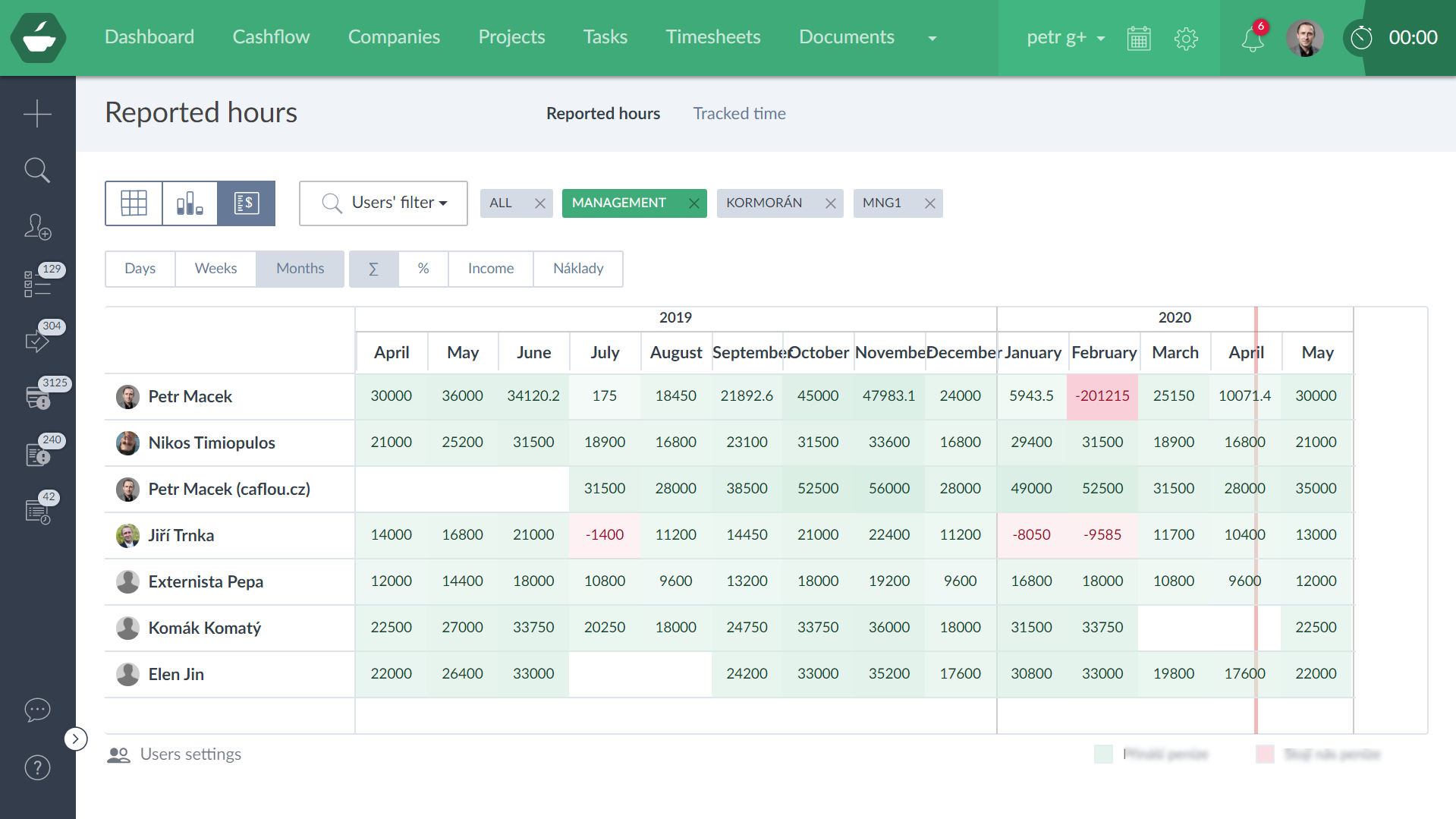Can remote work kill your organisation’s productivity?
According to a growing body of research, the opposite is more likely. Remote work options can reduce employee turnover, improve productivity, and increase employee satisfaction.
But, teams will only reap these benefits if they’re well managed. So, organisations need the right systems in place to streamline collaboration, optimise workflows, and cultivate a productive remote culture.
And thus, remote team management is crucial to achieving organisational excellence. Managers and team leaders must step up and ensure their teams are remote-ready.
But the road ahead isn’t easy.
🎓 The Caflou series “How to manage a company and a team remotely” is brought to you by CAFLOU® – business management system which is used to manage the performance and economy of your company, team and projects, 100% digitally, even remotely.
What are the challenges of managing remote employees?
Management and operational challenges
As a manager, it’s not enough to communicate your team members' responsibilities and expect them to deliver independently. To cultivate a culture of productivity, you will need to monitor their performance regularly and encourage a culture of self-accountability.
In a physical office, monitoring performance and productivity is a straightforward and organic task. Managers can simply check in with employees, asking how their work is coming along and whether they require any assistance. But a remote environment is inherently isolated.
Thus, in remote working conditions, it’s important to translate these management practices subtly. Managers must make sure that remote employees do not feel mistrusted or as if they’re being micromanaged. But finding the right balance can be challenging.
Workflow and collaboration challenges
In physical offices, communicating and collaborating with team members is natural. Employees are in the same physical space, so hopping over to a colleague’s desk or checking in with a manager is simple.
However, while remote communication is also straightforward in principle, workflow and collaboration challenges may still arise. Sometimes, remote workers may feel isolated and disconnected from their teams. They might not understand when to reach out, or how frequently to engage in video conferencing.
Thus, remote managers must establish systems of seamless collaboration and streamlined workflows. Each employee should know their responsibilities and how their efforts tie in with their team members to guarantee a productive working environment.
Technical and security challenges
Technical constraints and apprehensions surrounding data security exist for both physical and remote teams; however, the challenges are more significant for a remote workforce.
Modern organisations rely heavily on data, both for internal and external operations. We rely on data and systems to manage internal structures and economics. For example, we rely on technology for remote team management and collaboration, storing and migrating data, and managing client accounts and company economics.
Since remote teams operate entirely in the digital landscape, there is a greater risk of external threats and data leakage. For these reasons, it’s crucial to have the right technology and security measures in place.
Devising your action plan for remote team management
Remote work is growing in popularity, and eventually, all teams will be at least partially remote. This means managers must prepare for a remote-first future and the challenges that come with it.
💡 Do you know CAFLOU®? CAFLOU is a 100% digital management system which is used to manage the performance and economy of your company, team and projects, even remotely.

Audit internal operations
Your journey to successfully managing a remote team starts with identifying existing problems and bottlenecks. These challenges may be operational, technical, or administrative in nature.
The first step is to audit your internal operations and diagnose problems. The criteria for defining a ‘problem’ may vary depending on its nature. For example, the failure to meet specific KPIs may be due to workflow or productivity challenges.
Diagnose the problem sources
After identifying problems in your remote team’s performance, identifying the source of these challenges is crucial. For example, if productivity challenges exist, the cause may be poor collaboration, low employee morale, or a lack of accountability.
As a manager, your approach to problem diagnosis may vary depending on the issue. In general, it’s best to trust your gut and follow up on your suspicions. For example, if you suspect a problem exists due to low morale or poor collaboration, consider interviewing your employees 1:1 to learn more about their workflows.
Collecting feedback from your employees may also reveal problems that you weren’t aware of or unexpected sources. For example, your remote team may simply be missing the right tools and tech stack to collaborate effectively.
Set standards for communication and collaboration
Setting standards and outlining performance goals is crucial for effective remote team management. Your team members can’t meet goals that aren’t defined and tangible.
When it comes to setting these standards, it’s important to consider the nature of the work, the size of the team, and the workflow. Depending on these factors, you may need to define:
- A frequency of weekly alignment meetings between team members.
- Agendas for each meeting (these can be defined by team members themselves, if appropriate). Agendas help ensure productivity.
- Maximum meeting durations. It is entirely possible for team members to meet too frequently, reducing productivity and possibly affecting mental health. So, meetings should be kept to their necessary minimum.
Meetings and brainstorming sessions are vital, but remote team managers must monitor their effectiveness and regulate them when necessary. Don’t let them get out of hand.
Outline clear project workflows and goals
It’s not just meetings that need clear agendas and goals to be productive. For teams to function effectively, it’s crucial to define workflows and required goals for each project.
Team members must be clear on their roles and their required contributions.
Moreover, on an operational level, each employee should know how their contribution fits into the complete project workflow. Remote team members should know when to engage colleagues, which tasks require collaboration, and when their contribution is complete.
These requirements are necessary for any project workflow - physical or remote - but remote environments demand more management efforts. This is because the ecosystem is different - in a physical setting, colleagues share a vicinity and can gather in meeting rooms to collaborate.
Communication and conversation are organic.
However, in a remote environment, team members are physically isolated, raising the risk of disconnected workflows. Thus, remote team managers must be extra vigilant.
Define KPIs, productivity goals, and quality standards
The most effective teams operate and perform with minimal managerial intervention. To achieve such a productive landscape, managers must foster a culture of self-accountability and responsibility.
As we discussed earlier, the first step to achieving this goal is to streamline workflows and make sure employees are fully aware of their responsibilities. However, beyond this, managers must also define clear goals and outcomes for employees to strive towards.
These goals and outcomes will vary depending on the product’s requirements and nature. However, managers should:
- Define relevant KPIs for monitoring progress
- Outline productivity goals
- And set a standard for quality
Quality assurance is, of course, a continuous process, but outlining standards gives remote workers necessary strategic direction.

Leverage the right tech
Remote teams cannot exist without technology. And without the right tech, they cannot reach desired performance and productivity goals.
Earlier, we discussed how remote teams might struggle due to technical limitations. For example, team members may lack the right collaborative tools to share their work and receive feedback.
Sometimes, the challenges may extend to an entire department - for example, HR may struggle with recruitment and onboarding due to technical limitations.
In general, technology choices and implementation are managed by IT teams or departments. However, managers should monitor the operational efficiency of technology implementations - ensuring that workflows are seamless.
And where problems arise, remote managers should provide IT with a clear roadmap of the challenges and required solutions.
Continue testing, auditing, and improving
The most important realisation for remote team managers is that perfection is not attainable. Continuous improvement should thus be your mantra - managers should test theories for improving efficiency, and continuously audit workflows and processes. Then, where necessary, managers should intervene and continue to improve remote work environments.
In organisations of any kind, successful teams are adaptive.
How to establish a sustainable remote team management ecosystem
Till now, we’ve discussed immediate steps for managers to improve their remote team infrastructure. However, to establish a successful remote-first team or workforce, organisational changes are necessary.
The changes begin with re-evaluating your sourcing and recruitment efforts and end with ensuring talent retention.
Create a remote-first sourcing and onboarding pipeline
Designing a remote-first talent pipeline is one of the most effective long-term strategies for improving remote team management. The idea behind remote-first talent pipelines is to nurture your existing talent pool and help them prepare for remote working environments.
Moreover, employers can also highlight their remote working environment through their talent branding to attract remote-ready applications. When you optimise talent sourcing to acquire the right talent, managing the resulting team becomes sufficiently easier.
Encourage internal networking and team building
Maintaining employee morale and encouraging team building are crucial to your company’s culture. However, in remote settings, team bonding is less organic - largely due to physical isolation. So, managers must introduce systems to cultivate the right culture.
For example, virtual lunches and team building sessions can help remote employees network, bond, and get to know their teammates better. Moreover, training workshops and team building exercises can help remote employees improve their collaboration and get accustomed to working in remote environments.
Streamline remote team management with the right integrated solution
Most business processes and operations are tracked and managed digitally, whether your workforce is primarily remote, hybrid, or even on-site. Customer accounts are managed through CRMs and remote teams through collaboration software.
Additional functions such as HR’s role in payroll management may be handled through different tech stacks. Unfortunately, the more solutions you use, the more complicated business and team management become.
Your organisation will have to migrate, manage, and sync data across different platforms. Moreover, team members must be trained to use the different types of software.
Thus, many businesses can streamline their remote team management by using a fully integrated solution instead. The right management solution can integrate team collaboration, project management, business processes and economics, and more.
Remote work has become a staple in the modern world, and managers must thus be prepared to lead and grow remote and hybrid teams. That means empowering your remote team to work and communicate better, and fostering a healthy, productive work culture.
Moreover, a holistic approach to remote team management can help you achieve the best results. Creating a truly remote-ready workforce involves improving your talent sourcing, encouraging team building, fostering the right culture, and upgrading your tech stack.
You build the best teams when you hire the best people - and lead them well.
<< Back to all articles in the series How to manage a company and a team remotely